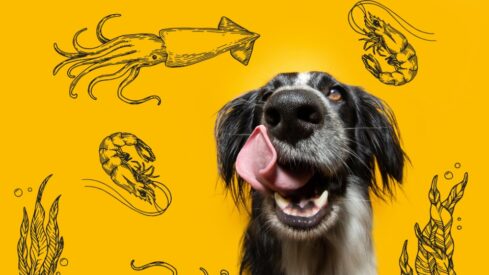How do squid and shrimp rate as novel protein sources for dog food?

Facing mounting challenges both economically and environmentally, the pet food industry is increasingly looking at utilizing aquatic organisms in its formulations.
The growth of the global pet population, mainly in developed countries, brings concerns about the economic, environmental and social sustainability of the pet food industry. Challenges include competition for ingredients with livestock and human food systems, the increased demands for quality and the environmental impact of rising pet food production.
The protein problem
Among macronutrients, protein stands out as the most expensive in both economic and ecological terms, making it arguably the nutrient that requires the most attention in terms of sustainability.
Therefore, increasing interest has emerged in alternative protein sources to replace conventional ones.
From a circular economy perspective, the utilization of by-products from aquatic sources holds the promise of alleviating negative environmental effects through waste reduction and enhancing economic and environmental efficiency.
This approach is particularly important due to the high volume of waste from aquatic production, particularly in regard to crustaceans and molluscs.
The utilization of by-products from these resources, with high protein content and bioactive compounds, may offer antioxidant, anticoagulant, anti-cancer, anti-inflammatory and antimicrobial effects that could be appealing to dog owners who are looking for functional pet foods.
Research into squid and shrimp
Although squid meal and shrimp hydrolysate have been studied as alternative feeds for livestock and are commonly used in the aquaculture sector, the information on dogs was non-existent.
However, researchers at the School of Medicine and Biomedical Sciences, University of Porto recently evaluated the chemical composition and antioxidant activity of these marine by-products from the human food chain and the effects of increasing levels of their dietary inclusion (5%, 10% and 15%) on palatability, digestibility, fecal characteristics, metabolites and microbiota of healthy adult dogs.
Chemical composition and antioxidant activity
Both by-products have proved to be great sources of protein (66% and 81% of crude protein, dry matter basis, respectively for shrimp hydrolysate and squid meal) and amino acids, particularly of arginine, lysine, leucine, glutamic acid plus glutamine and tyrosine, being the methionine content higher than that of ingredients traditionally used in dog food formulation.
While both marine by-products were shown to have antioxidant activity, this was heightened in shrimp hydrolysate, likely due to the presence of peptides released from protein breakdown during the process of enzymatic hydrolysis.
Palatability
Palatability is of crucial importance as it can affect food consumption. The addition of palatability enhancers is a common practice in the pet food industry and protein hydrolysates are extensively employed for this purpose.
A dietary inclusion of 15% of shrimp hydrolysate and squid meal did not affect first approach and first taste, both being protein sources well accepted by dogs.
Diet digestibility
The number of defecations, fecal dry matter content and consistency score – all highly valuable parameters for dog owners – were not affected by increasing levels of squid meal and shrimp hydrolysate inclusion.
Digestibility is also of importance to pet owners.
The experimental diets increased the digestibility of dry matter, nutrients and energy, with the major difference observed for protein, demonstrating the high potential of these ingredients to be included in highly digestible diets for dogs.
Fecal metabolites and microbiota
Gut health is influenced by a large variety of complex factors, and diet plays an important role in modulating microbiota profile and fecal metabolites.
Generally, the inclusion of squid meal had no effect on fecal pH, ammonia-N and total short-chain fatty acids production and profile.
Similarly, fermentation parameters were not affected by the level of inclusion of shrimp hydrolysate, but when compared with the control diet, this protein source increased total short-chain fatty acids production and individual concentrations, except for butyrate, which was unaffected.
It must be emphasized that the increase of acetate and propionate concentrations with shrimp hydrolysate inclusion might benefit canine health, namely through regulating host metabolic, immune and neuro-immuno-endocrine responses, and by lowering cholesterol.
No differences in the diversity of microbiota of feces of dogs fed the control diet and either squid meal or shrimp hydrolysate were observed, comprising mainly genera pertaining to Firmicutes, namely Turicibacter and Blautia, which are indicators of a healthy gut.
Conversely to squid meal, feeding dogs with different levels of shrimp hydrolysate diets affected microbiota composition, suggesting the potential of shrimp hydrolysate as a prebiotic.
Unlocking the potential
The potential of human food chain by-products, especially seafood, to be included in pet food is enormous and, at present, underexplored.
A global effort should be made to maximize the usage of such products – both from a circular economy perspective and in order to take full advantage of their bioactive compounds.
